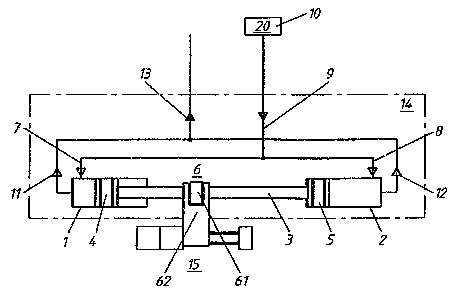Une partie des informations de ce site Web a été fournie par des sources externes. Le gouvernement du Canada n'assume aucune responsabilité concernant la précision, l'actualité ou la fiabilité des informations fournies par les sources externes. Les utilisateurs qui désirent employer cette information devraient consulter directement la source des informations. Le contenu fourni par les sources externes n'est pas assujetti aux exigences sur les langues officielles, la protection des renseignements personnels et l'accessibilité.
L'apparition de différences dans le texte et l'image des Revendications et de l'Abrégé dépend du moment auquel le document est publié. Les textes des Revendications et de l'Abrégé sont affichés :
| (12) Brevet: | (11) CA 2123161 |
|---|---|
| (54) Titre français: | POMPE A PISTON DOUBLE POUR L'ADMINISTRATION DE MEDICAMENT |
| (54) Titre anglais: | DOUBLE-PISTON PUMP FOR ADMINISTERING MEDICATION |
| Statut: | Durée expirée - au-delà du délai suivant l'octroi |
| (51) Classification internationale des brevets (CIB): |
|
|---|---|
| (72) Inventeurs : |
|
| (73) Titulaires : |
|
| (71) Demandeurs : |
|
| (74) Agent: | MARKS & CLERK |
| (74) Co-agent: | |
| (45) Délivré: | 2005-03-15 |
| (22) Date de dépôt: | 1994-05-09 |
| (41) Mise à la disponibilité du public: | 1994-11-11 |
| Requête d'examen: | 2000-05-02 |
| Licence disponible: | S.O. |
| Cédé au domaine public: | S.O. |
| (25) Langue des documents déposés: | Anglais |
| Traité de coopération en matière de brevets (PCT): | Non |
|---|
| (30) Données de priorité de la demande: | ||||||
|---|---|---|---|---|---|---|
|
Le dispositif de l'invention fournit des doses présélectionnées de médicaments liquides et possède un ensemble de cylindre (1, 2) avec un cylindre gauche (1), un cylindre droit (2) et un double piston (4, 5) montés de manière déplaçable dans l'ensemble avec une extrémité gauche du piston (4) et une extrémité de piston droite (5). Un accouplement relie le double piston d'une manière positive et/ou par friction avec une unité d'entraînement (15). Le dispositif est contrôlé passivement par deux soupapes d'admission à fermeture automatique (7, 8) et deux soupapes de décharge (11, 12). De ce fait un flux continu d'un médicament liquide 20 du récipient 10 à médicament peut être généré.
The device of the invention provides preselected doses of liquid medicine and has a cylinder assembly (1, 2) with a left cylinder (1), a right cylinder (2) and a double piston (4, 5) displaceably mounted in the assembly with a left piston end (4) and a right piston end (5). A coupling links the double piston in a positive and/or frictional manner with a drive unit (15). The device is controlled passively by two automatically closing intake valves (7, 8) and two discharge valves (11, 12). Thereby a continuous flow of liquid medicine 20 out of the medicine container 10 can be generated.
Note : Les revendications sont présentées dans la langue officielle dans laquelle elles ont été soumises.
Note : Les descriptions sont présentées dans la langue officielle dans laquelle elles ont été soumises.

2024-08-01 : Dans le cadre de la transition vers les Brevets de nouvelle génération (BNG), la base de données sur les brevets canadiens (BDBC) contient désormais un Historique d'événement plus détaillé, qui reproduit le Journal des événements de notre nouvelle solution interne.
Veuillez noter que les événements débutant par « Inactive : » se réfèrent à des événements qui ne sont plus utilisés dans notre nouvelle solution interne.
Pour une meilleure compréhension de l'état de la demande ou brevet qui figure sur cette page, la rubrique Mise en garde , et les descriptions de Brevet , Historique d'événement , Taxes périodiques et Historique des paiements devraient être consultées.
| Description | Date |
|---|---|
| Inactive : Périmé (brevet - nouvelle loi) | 2014-05-09 |
| Inactive : CIB de MCD | 2006-03-11 |
| Inactive : CIB de MCD | 2006-03-11 |
| Inactive : CIB de MCD | 2006-03-11 |
| Accordé par délivrance | 2005-03-15 |
| Inactive : Page couverture publiée | 2005-03-14 |
| Préoctroi | 2004-12-16 |
| Inactive : Taxe finale reçue | 2004-12-16 |
| Un avis d'acceptation est envoyé | 2004-09-27 |
| Un avis d'acceptation est envoyé | 2004-09-27 |
| Lettre envoyée | 2004-09-27 |
| Inactive : Approuvée aux fins d'acceptation (AFA) | 2004-09-15 |
| Modification reçue - modification volontaire | 2004-05-31 |
| Inactive : Dem. de l'examinateur art.29 Règles | 2003-12-02 |
| Inactive : Dem. de l'examinateur par.30(2) Règles | 2003-12-02 |
| Modification reçue - modification volontaire | 2000-10-31 |
| Lettre envoyée | 2000-05-15 |
| Inactive : Renseign. sur l'état - Complets dès date d'ent. journ. | 2000-05-15 |
| Inactive : Dem. traitée sur TS dès date d'ent. journal | 2000-05-15 |
| Toutes les exigences pour l'examen - jugée conforme | 2000-05-02 |
| Exigences pour une requête d'examen - jugée conforme | 2000-05-02 |
| Demande publiée (accessible au public) | 1994-11-11 |
Il n'y a pas d'historique d'abandonnement
Le dernier paiement a été reçu le 2004-04-19
Avis : Si le paiement en totalité n'a pas été reçu au plus tard à la date indiquée, une taxe supplémentaire peut être imposée, soit une des taxes suivantes :
Les taxes sur les brevets sont ajustées au 1er janvier de chaque année. Les montants ci-dessus sont les montants actuels s'ils sont reçus au plus tard le 31 décembre de l'année en cours.
Veuillez vous référer à la page web des
taxes sur les brevets
de l'OPIC pour voir tous les montants actuels des taxes.
Les titulaires actuels et antérieures au dossier sont affichés en ordre alphabétique.
| Titulaires actuels au dossier |
|---|
| MEDIMPEX ETS. |
| Titulaires antérieures au dossier |
|---|
| HEINZ HUGGENBERGER |